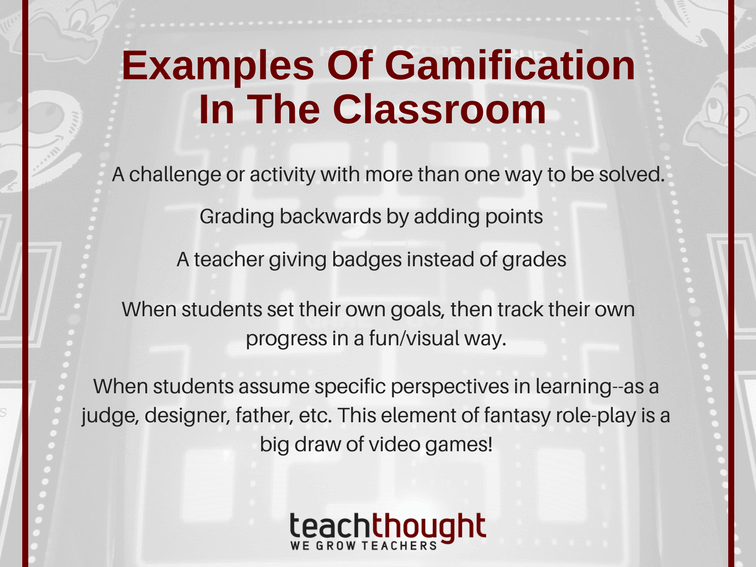
12 Examples Of Gamification In The Classroom


contributed by Ryan Schaaf & Jack Quinn
Everyone loves games.
Albert Einstein himself indicated they are the most elevated form of investigation. He knew games are avenues for something deeper and more meaningful than a childish waste of time. Games promote situated learning, or in other words, learning that occurs in groups of practice during immersive experiences. Oftentimes, playing games are the first method children use to explore higher-order thinking skills associated with creating, evaluating, analyzing, and applying new knowledge.
See also 50 Questions To Help Students Think About What They Think
This article is written in two parts. The first, written by Ryan Schaaf, Assistant Professor of Technology at Notre Dame of Maryland University, introduces gamification in an educational context, its many elements, and some products that emulate gamified practices. The second part, shared by classroom teacher and coach Jack Quinn, provides a firsthand account with perspective from a gamified learning practitioner. Below are our combined insights.
Gamification In An Educational Context
Games have many elements that make them powerful vehicles for human learning. They are commonly structured for players to solve a problem; an essential skill needed for today and tomorrow. Many games promote communication, cooperation, and even competition amongst players. Some of the most immersive games have a rich narrative that spawns creativity and imagination in its players. Finally, depending on how they are designed, games can both teach and test their players. They are incredible packages of teaching, learning, and assessment.
The structural elements of games are also especially suited to serve this current generation of learners. Commonly known as gamification (or gameful design according to Jane McGonigal), this approach of adding game elements such as storytelling, problem-solving, aesthetics, rules, collaboration, competition, reward systems, feedback, and learning through trial and error into non-game situations has already experienced widespread implementation in such fields as marketing, training, and consumerism with rampant success (see http://www.cio.com/article/2900319/gamification/3-enterprise-gamification-success-stories.html) for more details.
In the education realm, gamification is starting to pick up steam. With success stories such as Classcraft, Class Dojo, and Rezzly leading the charge, the potential for gamification to spread to more and more classrooms is a forgone conclusion. There are also pockets of educators in the teaching landscape that are designing their own ‘gamefully-designed’ learning environments. The next section explores such an environment by sharing Jack’s experiences with his own class.
See also 10 Specific Ideas To Gamify Your Classroom
Gamification: From Theory to Practice
I have been involved with gamification for quite some time now. In my 9 years of experience, I’ve found games are great at resolving several common classroom issues such as: student participation/talk time, student engagement, differentiation, data tracking, and increasing student achievement.
As an ancillary language teacher on Jeju Island in South Korea, gamification helped me increase student talk time by 300%. My 250 students completed over 27,000 ‘quests,’ a.k.a. additional homework assignments they chose to do. My top 10% of participants spent an hour outside of class speaking their target language daily. I was even startled on more than one occasion to arrive early to work and find my students had beaten me there and were eagerly awaiting my arrival so they could begin their daily quests.
As a classroom teacher in the Houston Independent School district serving schools with a 95% free and reduced lunch population, I have taught both 3rd-grade reading and 5th-grade science. Each of these is a state-tested subject (that I taught for two years).
On average in my first year of instruction, my students have performed 1.39 times the district norm and 1.82 times the district norm in my second year teaching the subject. Or put another way, traditional methods would take 14 to 18 months to achieve what I can do with games in 10.
I credit much of this success to following the advice of Gabe Zicherman from his Google Tech Talk, Fun is the Future: Mastering Gamification, where he advises game designers to “incentivize whatever you want people to do.” (Zicherman, n.d.)
As such I strive to identify the key actions my students need to practice then build games and reward systems around those actions.
Gamification in education uses the mechanics of games—points, levels, competition, challenges, and rewards—to motivate students and make learning more engaging. Below are 20 practical, classroom-tested examples of gamification that teachers can use to boost motivation and participation.
1. Giving Points for Meeting Academic Objectives
Do students need to cite details from the text and support conclusions with evidence? Award 1 point for an answer without evidence, 2 points for one piece of evidence, and 3 points for multiple pieces of evidence. This makes evidence-based thinking measurable and motivating.
2. Giving Points for Procedural or Non-Academic Objectives
Want to shorten the time it takes to check homework? Award 2 points to every student who has their work out before being prompted. This gamifies procedures and encourages self-management.
3. Creating Playful Barriers or Challenges
Introduce fun obstacles—puzzles, riddles, or time-based challenges—that students must overcome to unlock the next step of a lesson. These barriers increase engagement and mirror the challenge-reward loop in games.
4. Creating Healthy Competition in the Classroom
Try Teacher vs. Class: Students earn points collectively when they follow rules; the teacher earns points when they don’t. If students win, reward them with a 1-minute dance party, extra recess, or reduced homework.
5. Comparing and Reflecting on Performance
After a project, provide students with a performance breakdown—badges for creativity, teamwork, or perseverance, plus statistics like “most questions asked” or “highest number of drafts.” Reflection is a core element of gamification.
6. Creating a Range of Unique Rewards
Offer tiered rewards that appeal to different personalities. For example: sunglasses for 5 points, shoes-off privilege for 10, a positive parent text for 15, or the right to “steal” the teacher’s chair for the highest scorer.
7. Using Levels, Checkpoints, and Progression
Track points over multiple days or weeks and let students level up at milestones. Higher levels unlock privileges, mentor roles, or bonus challenges—mirroring video game progression systems.
8. Grading Backward
Instead of starting from 100, let students earn points toward mastery. Each correct answer, skill demonstration, or positive behavior moves them closer to 100. This approach reframes learning as growth rather than loss avoidance.
9. Creating Multi-Solution Challenges
Design tasks with more than one valid solution and encourage students to compare strategies. Reward creative or unique solutions to encourage divergent thinking.
10. Using Learning Badges
Instead of (or alongside) grades, offer digital or paper badges for achievements like “Critical Thinker,” “Collaboration Pro,” or “Master of Fractions.” Badges make learning goals tangible and collectible.
11. Letting Students Set Their Own Goals
Allow students to set personalized goals, then track their progress visually on a class leaderboard, sticker chart, or digital tracker. Self-directed goal-setting is motivating and teaches ownership.
12. Helping Students Assume Roles or Personas
Use role-play to have students act as judges, designers, or historians while working on assignments. Role-based learning taps into the immersive nature of games.
13. Classroom Quests and Storylines
Wrap units or lessons in a narrative arc (e.g., “Survive the Ancient Civilization”) where students unlock new “chapters” by completing assignments.
14. Time-Limited Boss Battles
End a unit with a collaborative review challenge where students must “defeat the boss” (answer a set of challenging problems) before the timer runs out.
15. Randomized Rewards
Use a mystery reward system: when students earn enough points, let them draw from a reward jar. The unpredictability keeps motivation high.
16. Digital Leaderboards
Create a leaderboard for cumulative points, badges, or completed challenges. Public recognition motivates competitive students but should be framed positively to avoid shaming lower performers.
17. Power-Ups for Positive Behavior
Introduce power-ups such as “extra hint,” “skip one homework problem,” or “sit anywhere pass.” Students can spend earned points to activate them.
18. Cooperative Class Goals
Set a shared objective—if the entire class meets a point total, they earn a group reward like a read-aloud day, a project celebration, or bonus recess.
19. Daily Streaks
Track daily participation or homework completion with streak mechanics like those used by language-learning apps. Breaking a streak resets progress, encouraging consistency.
20. Unlockable Bonus Content
Provide bonus activities or secret levels (puzzles, videos, enrichment problems) that students can unlock after meeting a point threshold. This gives advanced students additional challenges.
Why Gamification Works
Gamification turns routine tasks into engaging challenges, encourages intrinsic and extrinsic motivation, and provides continuous feedback. When applied thoughtfully, it promotes mastery, collaboration, and a sense of progress.
Learn more about gamification in learning, explore game-based learning strategies, and get tips for increasing student engagement.
Bonus: Using a scoreboard seating chart
Draw or project a seating chart onto a whiteboard/screen, and then award students points for all activities that you want to incentivize with sustainable rewards/recognitions at different point levels.
Conclusion
Make sure to be creative and respond to student interests. In my class, students don’t take practice tests; they battle the evil emperor, Kamico (the maker of popular test prep workbooks used at my school). We don’t just test objects for conductivity; we search out the secret object which will turn on the alien spaceship’s ‘prepared to launch’ light.
While students are collecting points, leveling up, and competing against each other, I am collecting data, tracking progress, and tailoring the rules, rewards, and quests to build positive class culture while pushing student achievement. Students become eager to participate in the activities that they need to do to improve, and when students buy-in, they make school a game worth playing.
References & Further Reading
McGonigal, J. (2011). Gaming can make a better world. | TED Talk | TED.com [Video file]. Retrieved from: ted.com/
Schaaf, R., & Mohan, N. (2014). Making school a game worth playing: Digital games in the classroom. SAGE Publications.
Schell, J. (n.d.) When games invade real life. | TED Talk | TED.com [Video file]. Retrieved from https://www.ted.com/talks/jesse_schell_when_games_invade_real_life
Zicherman. (n.d.). Fun is the Future: Mastering Gamification [Video file]. Retrieved from youtube.com
12 Examples Of Gamification In The Classroom
Source link



